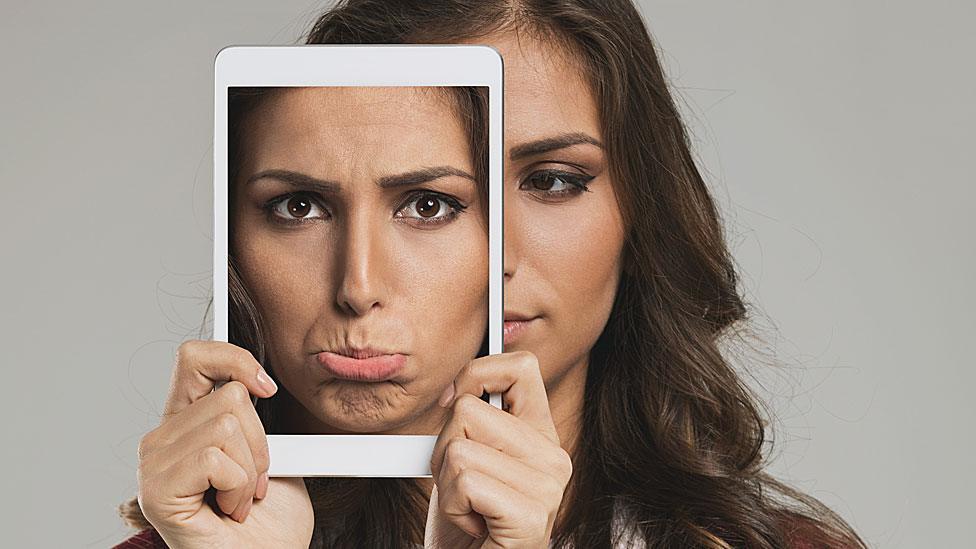'Mesearch' - when study really is all about me
- Published

Is the selfie culture coming into serious academic research? Or is it a valid way of using first-hand experience?
There are strong opinions about an increasingly popular international research method which has been dubbed "mesearch".
"Mesearch", which is properly known as autoethnography, is when a researcher uses their personal experiences to tackle academic questions.
Critics dismiss it as "unscientific", "academic narcissism" and "diary-writing for the over-educated".
They say it is a very modern phenomenon - a high-brow version of taking selfies, watching reality television and posting thoughts into the echo chambers of social media.
But it is being used in many fields like sociology, education and psychology, published by mainstream journals, and taught in universities in the United States.
The term autoethnography dates back to the 1970s, and an early study described a researcher's "unsuccessful self-treatment of a case of writer's block".
The fact the article was published suggests he managed to overcome the problem in the end.
Mirror image
While most qualitative researchers base their theories on in-depth interviews with a small number of people, an autoethnographer only uses his or her own experiences and feelings to understand a wider subject.
Autoethnographic articles are often written in the form of a story, rather than precise academic language.

There are claims that "mesearch" gives perspectives missing from conventional research
This is a break from the traditional scientific method which requires academics to be objective and detached from their subject, and base their theories on data and experiments that can be tested, verified and reproduced.
So it is not surprising that many academics are suspicious - even the name "mesearch" is used to undermine the method.
Vincent F Hendricks, professor of formal philosophy at the University of Copenhagen in Denmark, says autoethnography fails to meet the standard criteria for science.
He says autoethnographic studies cannot claim to have "falsifiability, testability, representability, extrapolation, prediction, and other conditions securing reliable scientific enquiry".
Wider voices
Sceptical academics have taken to Twitter to expose what they regard as the most self-indulgent and unscientific examples of autoethnography.
Their latest targets include a researcher using her experience of learning how to do glassblowing to understand hand-eye coordination, and an academic describing how walking in the hills helped him to develop his sense of identity.
Another autoethnographer recently described how Donald Trump's presidential election victory left him unable to sleep.
All three were published in peer-reviewed journals.

More stories from the BBC's Global education series, external looking at education from an international perspective, and how to get in touch.
You can join the debate at the BBC's Family & Education News Facebook page, external.

Professor Carolyn Ellis of the University of South Florida, who is one of the world's leading autoethnographers, rejects the charges of "narcissism".
"It's narcissistic to leave out your own experience and to act all-knowing, as though you can stand apart, and that you are not subject to the same forces as those you write about," she says.
"It's narcissistic to think that "we" academics should write only about "them" and not subject ourselves to the same scrutiny.
She says autoethnography has given a voice to people from working class, ethnic minority and indigenous backgrounds "who would not have written otherwise in the more traditional social science prose".
First hand accounts
Prof Ellis argues that an autoethnographic approach can give insights which would not be possible using traditional research methods.
For example, she has challenged theories about "minor bodily stigmas" by giving an honest and personal account of why she has always disliked her own lisp.

Does the idea of "mesearch" come out of a culture of social media and reality television?
She also says training in autoethnography can make someone a better teacher.
By sharing her stories with a class, she says it "creates a positive atmosphere in the course" which encourages students to open up about "the issues that really concern them and they care about".
Other advocates of the method say it allows people to share experiences in greater depth and analyse their meaning.
Dr Jill Bolte Taylor from Harvard University made first-hand observations about the workings of the brain and how it is rehabilitated while she recovered from a stroke.
She says that watching her brain deteriorate gave her "an understanding of the brain that academia could not teach me" - and wrote a book about it called My Stroke of Insight.
Could Sir Isaac Newton's revelation about gravity after an apple fell on his head, and Descartes' observation that "I think, therefore I am", be called examples of autoethnography?
"You'd have to ask them, but I'd have no problem calling these observations autoethnographic," says Prof Ellis.
'Self-indulgent'
The Journal of Loss and Trauma has now published almost 100 autoethnographic studies, and its editor Prof John Harvey says the technique can be useful for the in-depth study of traumatic events.
But he warns that autoethnographic studies often struggle to make the case that one person's story represents the likely experiences of a wider group.
Autoethnography's rise shows no sign of stopping - with more journals publishing studies and more universities offering courses in the method.
This means more work for the next generation of autoethnographers, and more work for the cynics who trawl journals for "self-indulgent" studies to mock on Twitter.